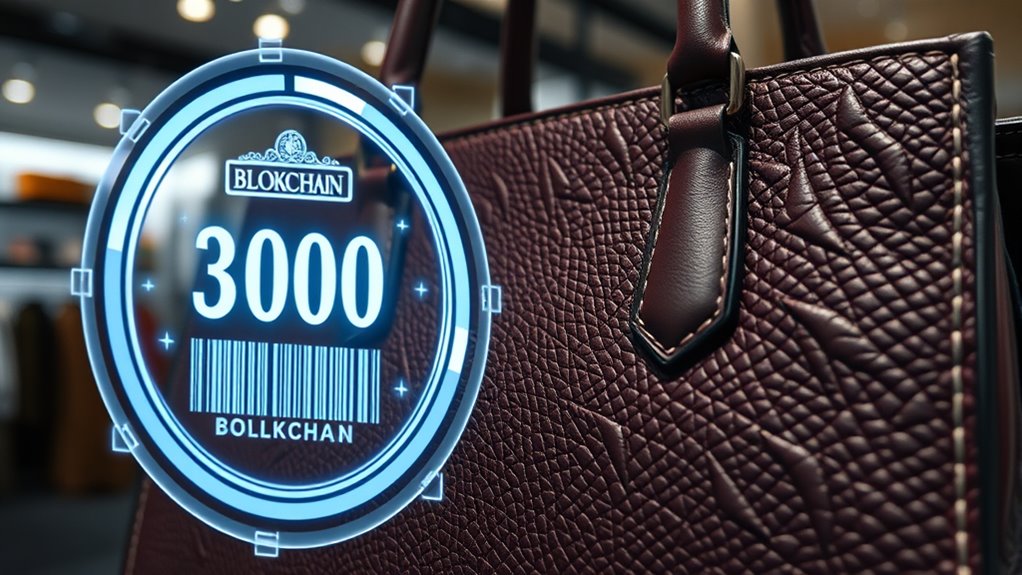Blockchain is helping you fight counterfeit designer bags by providing secure digital passports and certificates that verify authenticity. It records each bag’s ownership history on a transparent, tamper-proof ledger, making fakes easier to spot. Apps using blockchain let you instantly confirm a bag’s provenance and authenticity with a simple scan. As technology advances, you’ll discover even more ways blockchain is creating trustworthy, secure experiences in luxury fashion.
Key Takeaways
- Blockchain creates immutable records of a designer bag’s origin, ownership, and transfer history to verify authenticity.
- Digital signatures and tamper-proof watermarks embedded with blockchain technology help identify genuine products quickly.
- Smart contracts automate ownership transfers, ensuring secure and transparent transactions without third-party appraisers.
- Distributed ledger technology provides a permanent, unalterable provenance trail that deters counterfeit attempts.
- Blockchain-enabled digital certificates and QR codes enable consumers to instantly verify a bag’s authenticity via scanning.
Understanding the Problem of Counterfeit Designer Bags
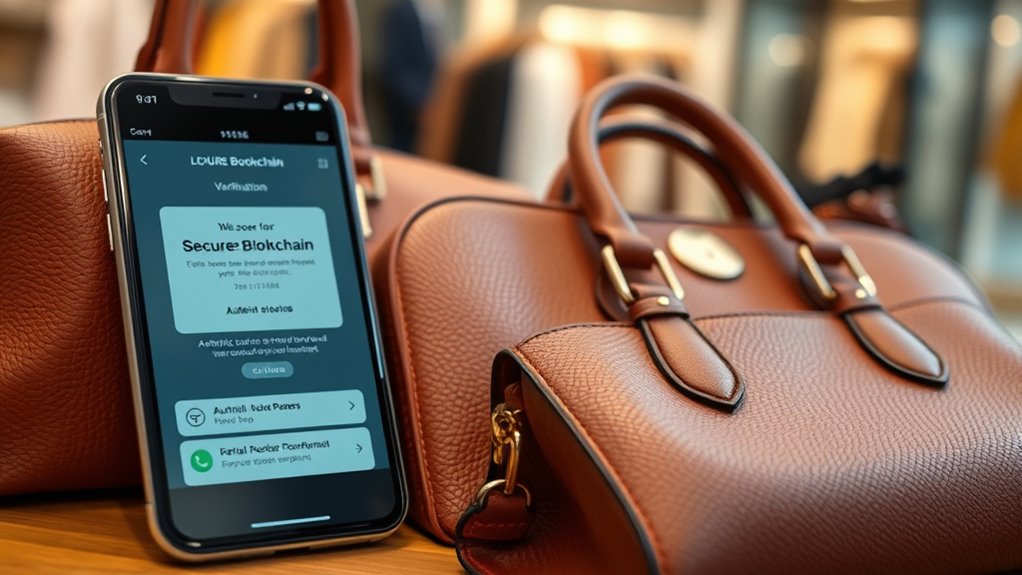
Counterfeit designer bags pose a significant challenge to both brands and consumers. In counterfeit markets, fake bags flood streets and online platforms, making it hard to distinguish genuine items from imitations. These counterfeit products threaten designer branding by diluting exclusivity and damaging reputations. As a consumer, you might unknowingly buy a fake, thinking it’s authentic, which undermines your confidence in luxury brands. For brands, counterfeit markets mean lost sales and diminished brand value. The proliferation of counterfeit designer bags also fuels illegal activities and undermines intellectual property rights. Recognizing the scope of this problem is essential; it highlights the need for reliable authentication methods to protect both consumers and authentic brands from the widespread influence of counterfeit markets. Implementing anti-counterfeiting measures such as blockchain technology can help verify the authenticity of products and combat the spread of fakes more effectively. As technology advances, innovative solutions like blockchain verification are becoming increasingly vital in safeguarding brand integrity and consumer trust. Additionally, the complex nature of counterfeit markets makes it increasingly difficult for traditional methods to keep pace with sophisticated fake production techniques, emphasizing the importance of adopting advanced authentication technologies.
The Basics of Blockchain Technology in Authentication
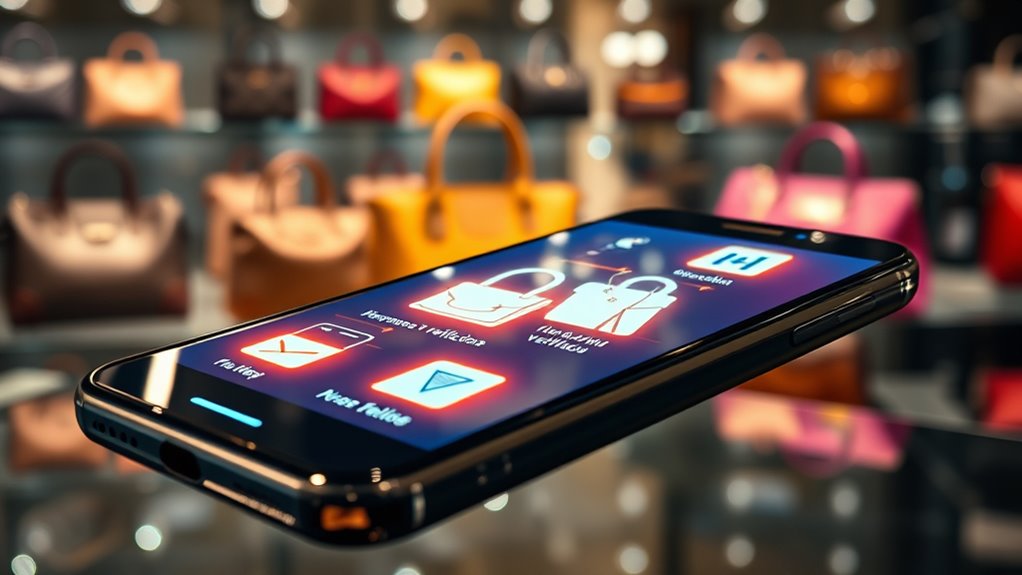
Blockchain technology offers a secure and transparent way to authenticate designer bags by creating an unchangeable digital record of their origin and ownership. Each bag is assigned a unique digital signature that verifies its authenticity. These signatures are cryptographically secured, preventing tampering or forgery. Smart contracts automate the verification process, ensuring that ownership transfers or authenticity checks happen seamlessly and securely. When a bag changes hands, the smart contract updates the blockchain record instantly, maintaining a trustworthy history. This system eliminates the need for third-party appraisers and reduces counterfeit risks. By leveraging digital signatures and smart contracts, blockchain provides a reliable, tamper-proof platform for authenticating luxury goods, giving you confidence in a product’s provenance and protecting your investments. Additionally, the contrast ratio of the system helps ensure the clarity and legibility of digital signatures on the blockchain. Incorporating security protocols further enhances the integrity and trustworthiness of the blockchain-based authentication process. Implementing digital signatures ensures that each item’s unique identity remains secure and verifiable throughout its lifecycle. The use of decentralized ledgers enhances data integrity and prevents single points of failure. Combining these features with user-friendly interfaces can make the authentication process more accessible to consumers and retailers alike.
Implementing Digital Passports and Certificates for Luxury Goods
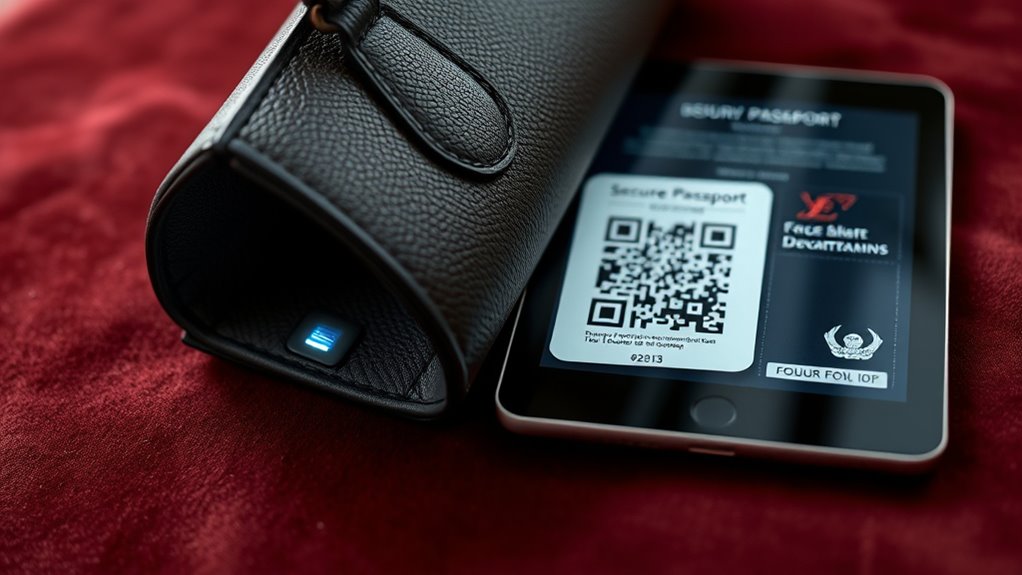
Implementing digital passports and certificates transforms how you verify the authenticity of luxury goods. You use blockchain-enabled solutions that incorporate digital watermarking, embedding unique identifiers into each item’s digital certificate. These watermarks are tamper-proof and can be easily scanned to confirm authenticity. Smart contract enforcement guarantees that the digital passport remains secure, automatically validating ownership and transfer history whenever a product changes hands. This seamless process reduces counterfeit risks and provides consumers with confidence. By integrating these digital certificates into blockchain systems, luxury brands can create a trusted layer of verification that’s accessible worldwide. This approach not only enhances security but also streamlines authentication, making it easier for you to distinguish genuine items from counterfeit ones. Additionally, leveraging encryption solutions ensures the confidentiality and integrity of the data exchanged during the verification process, and the use of blockchain technology further enhances transparency and traceability in the supply chain. Incorporating personality insights can help brands better understand consumer trust and engagement with these new verification methods. Furthermore, adopting tamper-proof digital watermarks adds an extra layer of security by making counterfeit detection even more reliable. Recognizing the importance of unique identifiers, brands can ensure each product has a distinct digital footprint, reducing duplication and fraud.
Tracking and Verifying Bag Provenance Through Distributed Ledgers
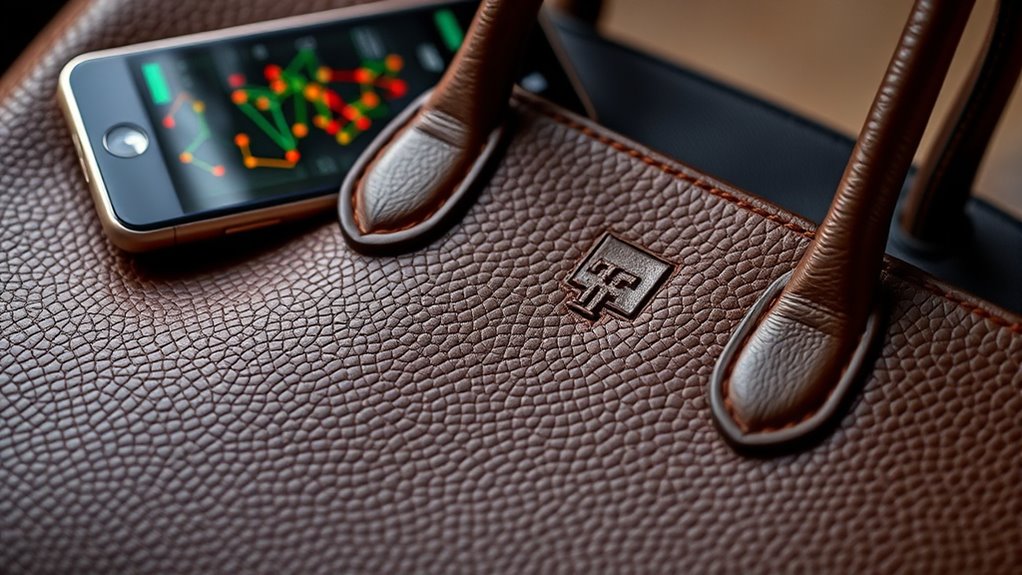
With distributed ledgers, you can access immutable provenance records that securely trace a bag’s history. This makes it easy to verify authenticity and confirm that the item is genuine. Plus, the transparent ownership history helps you confidently track each step of the bag’s journey. Incorporating trust-building strategies, such as blockchain verification, can further enhance customer confidence in luxury authenticity. Retailers may also utilize store hours to ensure clients can access verification services at convenient times, improving overall trust. Additionally, implementing proper organization of the provenance data ensures that all records are maintained efficiently and can be easily accessed when needed. Understanding the horsepower of electric dirt bikes can inspire innovative ways to enhance tracking systems by applying lightweight and efficient technologies to digital verification processes. Furthermore, ensuring compliance with divorce process requirements can serve as a metaphor for maintaining thorough and transparent record-keeping in digital systems.
Immutable Provenance Records
Because each transaction is recorded on a distributed ledger, provenance records become inherently immutable, providing an unalterable history of a bag’s journey from creation to resale. This means you can trust the data without fear of tampering. Digital signatures ensure each transaction is securely verified by the involved parties, confirming authenticity and ownership. Smart contracts automate and enforce transfer rules, preventing unauthorized changes or counterfeiting attempts. As a result, every step—manufacture, sale, or resale—is transparently documented and permanently stored. You gain a clear, trustworthy trail that proves a bag’s origin and authenticity. Additionally, blockchain security measures can help monitor and detect suspicious activities within the blockchain system, enhancing overall security. Implementing provenance verification tools further strengthens the integrity of the records, making it more difficult for counterfeiters to deceive buyers. Incorporating Digital signatures ensures each transaction remains securely verified and tamper-proof throughout the process. Moreover, understanding the importance of creative practice can inspire innovative approaches to developing more robust and user-friendly verification systems.
Authenticity Verification Process
Tracking and verifying the authenticity of a designer bag using blockchain technology involves examining its detailed provenance recorded on a distributed ledger. You can confirm a bag’s origin by checking the blockchain’s digital signatures, which ensure the data’s integrity and authenticity. When a bag’s information is added, a smart contract automatically verifies relevant details like manufacturer, transfer history, and ownership claims. These contracts execute predefined rules, ensuring all recorded transactions are valid and tamper-proof. As a result, you gain confidence that the bag’s provenance is genuine and unaltered. Blockchain technology also utilizes secure cryptographic methods to protect the data from unauthorized access or modification. By leveraging digital signatures and smart contracts, the process becomes transparent, secure, and efficient—making counterfeit attempts considerably more difficult while providing you with a reliable method to verify authenticity.
Transparent Ownership History
A detailed ownership history is essential for verifying a designer bag’s authenticity, and blockchain technology makes this process transparent and tamper-proof. With digital ownership recorded on a distributed ledger, you can track every transaction securely, from the original creator to the current owner. This secure tracking prevents counterfeiters from altering or falsifying provenance records. When you scan a bag’s digital certificate, you gain instant access to its complete ownership history, ensuring authenticity at every step. Blockchain’s immutable nature guarantees that the provenance data remains unchangeable and trustworthy. As a result, buyers, sellers, and collectors can confidently verify a bag’s genuine origin, reducing fraud and increasing transparency in the luxury market. This technology empowers you to make informed purchases backed by secure, verifiable data.
Enhancing Customer Confidence With Blockchain-Enabled Apps

Blockchain-enabled apps are transforming how customers verify the authenticity of designer bags, giving you greater confidence in your purchases. These apps boost your digital reputation and strengthen customer trust by providing secure, transparent verification tools. With a simple scan or input, you can access detailed information about a bag’s provenance, ownership history, and authenticity status. This immediate access reassures you that your investment is genuine. Additionally, these apps often include features like:
- Real-time updates on ownership and authenticity
- Secure digital certificates stored on the blockchain
- User reviews and ratings to build community trust
- Alerts on potential counterfeit risks
Challenges and Limitations of Blockchain in Counterfeit Prevention
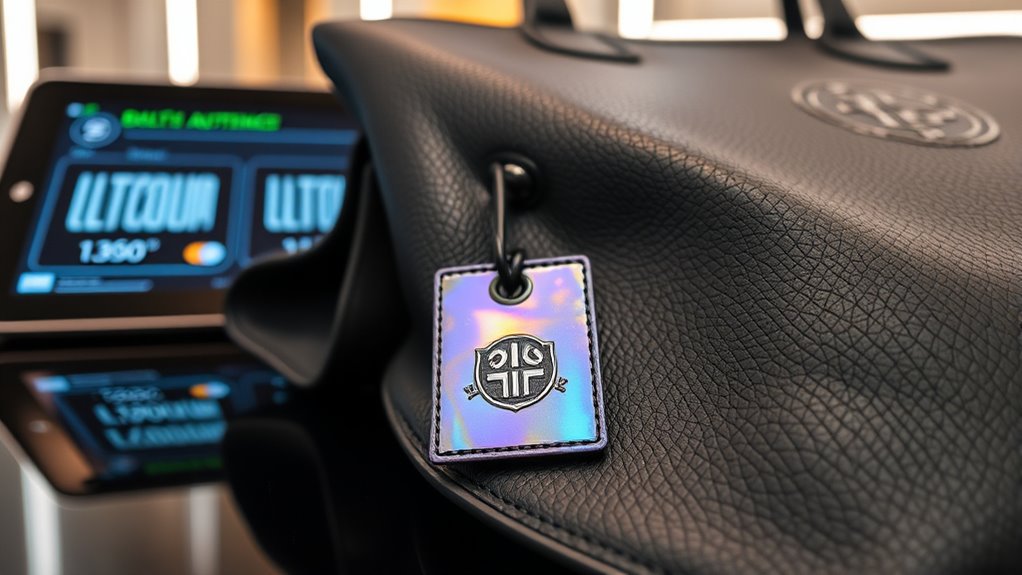
Implementing blockchain for counterfeit prevention can be expensive and complicated, making it tough for brands to adopt. You might also face technological hurdles and resistance from stakeholders unfamiliar with the system. These challenges can limit blockchain’s effectiveness in stopping counterfeit designer bags.
Implementation Complexities and Costs
Despite its potential, adopting blockchain technology for counterfeit prevention involves significant complexities and costs. You need to perform a thorough cost analysis to understand expenses like infrastructure setup, ongoing maintenance, and staff training. Integration challenges also arise, as blockchain systems must seamlessly connect with existing supply chain platforms and databases. These technical hurdles can delay deployment and increase costs. Additionally, establishing standards and protocols requires collaboration among multiple stakeholders, adding to complexity. Here are some key points to contemplate:
- High initial investment for blockchain infrastructure
- Ongoing expenses for system updates and security
- Difficulties integrating with legacy supply chain systems
- Costs associated with staff training and change management
Understanding these factors helps you weigh the true costs of implementing blockchain for counterfeit prevention.
Technological and Adoption Barriers
While the promise of blockchain for counterfeit prevention is significant, several technological and adoption barriers can hinder its effectiveness. One challenge is ensuring robust digital security; if blockchain systems aren’t properly protected, they become vulnerable to hacking and data breaches, risking user trust. Additionally, balancing user privacy with transparency poses a dilemma—stakeholders want transparency to verify authenticity but also need to protect sensitive information. Adoption resistance is another obstacle, as brands and consumers may be hesitant to embrace new technology due to unfamiliarity or perceived complexity. Limited technical infrastructure and lack of standardized protocols can slow deployment. Overcoming these barriers requires addressing digital security concerns proactively and designing solutions that respect user privacy, encouraging broader acceptance and effective implementation.
Future Trends and Innovations in Blockchain and Luxury Fashion
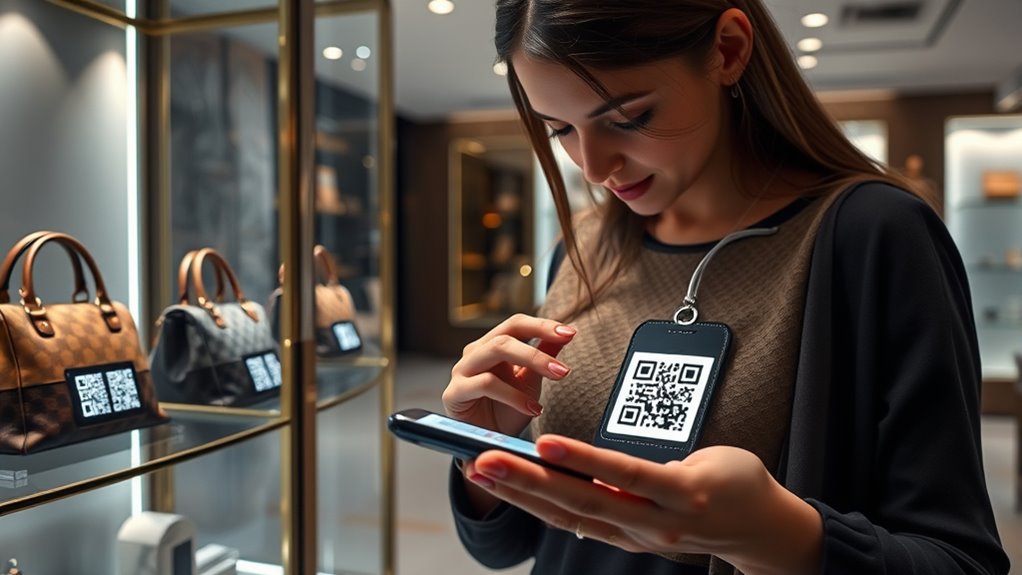
As blockchain technology continues to evolve, it is poised to revolutionize the luxury fashion industry by enhancing transparency and authentication processes. Future trends include increased cryptocurrency integration, allowing seamless transactions and ownership transfers. Virtual fashion shows are also gaining momentum, showcasing digital collections secured by blockchain, which helps confirm authenticity. You can expect to see brands leveraging these innovations to create more immersive, secure experiences. Blockchain’s role in verifying provenance will expand, reducing counterfeit risks further. Additionally, the development of digital twins—virtual replicas of physical designer bags—will become standard, enabling you to verify authenticity instantly. These trends promise a more transparent, secure, and engaging luxury fashion landscape, empowering you with greater confidence in your purchases and experiences.
- Cryptocurrency payments becoming mainstream
- Virtual shows replacing traditional runway events
- Digital twins for instant verification
- Blockchain-driven provenance tracking
Frequently Asked Questions
How Secure Is Blockchain Against Hacking or Data Manipulation?
Blockchain is highly secure because of its cryptographic safeguards and decentralization resilience. You benefit from cryptographic protocols that protect your data from hacking, making it tough for attackers to alter information. Its decentralized nature means no single point of failure, so even if some parts are compromised, the overall system remains intact. While no technology is completely invulnerable, blockchain offers a robust and secure environment for sensitive transactions and data.
Can Blockchain Solutions Be Easily Integrated With Existing Luxury Brand Systems?
Imagine you’re in a world where blockchain seamlessly integrates with your luxury brand systems like a vintage record player syncing with modern speakers. You might face some integration challenges and system compatibility issues, but these are manageable with the right technical expertise. Blockchain solutions are designed for adaptability, making it possible to incorporate them into existing infrastructure, ultimately strengthening your fight against counterfeits while streamlining operations.
What Costs Are Involved in Implementing Blockchain for Authentication?
When you consider implementing blockchain for authentication, you should perform a thorough cost analysis to understand the expenses involved. Costs include technology development, integration, and ongoing maintenance. Be aware of investment risks, such as fluctuating blockchain technology costs or potential scalability issues. While initial investments can be significant, the long-term benefits of enhanced security and brand protection can outweigh these costs, making blockchain a worthwhile investment for fighting counterfeits.
How Do Blockchain-Based Systems Handle Counterfeit Bags From Third-Party Sellers?
Coincidences often reveal hidden truths, and blockchain-based systems excel at exposing counterfeit bags from third-party sellers. You get digital fingerprinting that’s unique to each authentic item, making it easy to verify its origin. Supply chain verification guarantees every step is transparent, so you can trace a bag’s journey from creation to sale. This layered approach helps you confidently identify genuine products, reducing the risk of counterfeit purchases.
Are There Legal or Privacy Issues With Using Blockchain to Verify Authenticity?
You might worry about privacy concerns or legal compliance when using blockchain to verify authenticity. Blockchain’s transparency can raise privacy issues if personal data isn’t properly safeguarded, and regulations vary across regions. To stay compliant, you should ensure that data handling follows privacy laws like GDPR or CCPA. By addressing these concerns proactively, you can leverage blockchain securely while respecting legal boundaries and protecting user privacy.
Conclusion
While blockchain brings transparency and security to fight counterfeit designer bags, it’s not a magic fix—you still need vigilance and trust in the process. Just like spotting a fake requires a keen eye, understanding this technology helps you make smarter choices. In a world where luxury meets innovation, embracing blockchain is your key to authenticity. So, stay informed and confident, because even in high-tech battles, your knowledge remains your best accessory.
